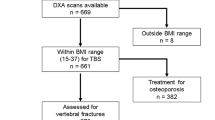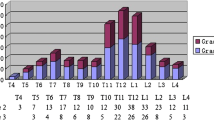Abstract
Summary
Detection of patients with vertebral fracture is similar for areal bone mineral density (aBMD) and trabecular bone score (TBS) in patients with non-vertebral fracture. In non-osteoporotic patients, TBS adds information to lumbar spine aBMD and is related to an index of spine deterioration.
Introduction
Vertebral fractures (VFs) are more predictive of future fracture than aBMD. The number and severity of VFs are related to microarchitecture deterioration. TBS has been shown to be related to microarchitecture. The study aimed at evaluating TBS in the prediction of the presence and severity of VFs.
Methods
Patients were selected from a Fracture Liaison Service (FLS): aBMD and vertebral fracture assessment (VFA) were assessed after the fracture, using dual-energy X-ray-absorptiometry (DXA). VFs were classified using Genant's semiquantitative method and severity, using the spinal deformity index (SDI). TBS was obtained after analysis of DXA scans. Performance of TBS and aBMD was assessed using areas under the curves (AUCs).
Results
A total of 362 patients (77.3 % women; mean age 74.3 ± 11.7 years) were analysed. Prevalence of VFs was 36.7 %, and 189 patients (52.2 %) were osteoporotic. Performance of TBS was similar to lumbar spine (LS) aBMD and hip aBMD for the identification of patients with VFs. In the population with aBMD in the non-osteoporotic range (n = 173), AUC of TBS for the discrimination of VFs was higher than the AUC of LS aBMD (0.670 vs 0.541, p = 0.035) but not of hip aBMD; there was a negative correlation between TBS and SDI (r = −0.31; p < 0.0001).
Conclusion
Detection of patients with vertebral fracture is similar for aBMD and TBS in patients with non-vertebral fracture. In patients with aBMD in the non-osteoporotic range, TBS adds information to lumbar spine aBMD alone and is related to an index of spine deterioration.



Similar content being viewed by others
References
Cummings SR et al (1993) Bone density at various sites for prediction of hip fractures. The Study of Osteoporotic Fractures Research Group. Lancet 341:72–75
Marshall D, Johnell O, Wedel H (1996) Meta-analysis of how well measures of bone mineral density predict occurrence of osteoporotic fractures. BMJ 312:1254–1259
Stone KL et al (2003) BMD at multiple sites and risk of fracture of multiple types: long-term results from the Study of Osteoporotic Fractures. J Bone Miner Res 18:1947–1954
Siris ES et al (2001) Identification and fracture outcomes of undiagnosed low bone mineral density in postmenopausal women: results from the National Osteoporosis Risk Assessment. JAMA 286:2815–2822
Miller PD et al (2002) Prediction of fracture risk in postmenopausal white women with peripheral bone densitometry: evidence from the National Osteoporosis Risk Assessment. J Bone Miner Res 17:2222–2230
Schuit SC et al (2004) Fracture incidence and association with bone mineral density in elderly men and women: The Rotterdam Study. Bone 34:195–202
Netelenbos JC, Lems WF, Geusens PP et al (2009) Spine radiographs to improve the identification of women at high risk for fractures. Osteoporos Int 20:1347–1352
Siris ES, Genant HK, Laster AJ, Chen P, Misurski DA, Krege JH (2007) Enhanced prediction of fracture risk combining vertebral fracture status and BMD. Osteoporos Int 18:761–770
Black DM, Arden NK, Palermo L, Pearson J, Cummings SR (1999) Prevalent vertebral deformities predict hip fractures and new vertebral deformities but not wrist fractures. Study of Osteoporotic Fractures Research Group. J Bone Miner Res 14:821–828
Kerkeni S, Kolta S, Fechtenbaum J, Roux C (2009) Spinal deformity index (SDI) is a good predictor of incident vertebral fractures. Osteoporos Int 20:1547–1552
Genant HK, Delmas PD, Chen P et al (2007) Severity of vertebral fracture reflects deterioration of bone microarchitecture. Osteoporos Int 18:69–76
Hordon LD, Raisi M, Paxton S, Beneton MM, Kanis JA, Aaron JE (2000) Trabecular architecture in women and men of similar bone mass with and without vertebral fracture: part I. 2-D histology. Bone 27:271–276
Nevitt MC, Ettinger B, Black DM et al (1998) The association of radiographically detected vertebral fractures with back pain and function: a prospective study. Ann Intern Med 128:793–800
O'Neill TW, Cockerill W, Matthis C (2004) Back pain, disability, and radiographic vertebral fracture in European women: a prospective study. Osteoporos Int 15:760–765
Cockerill W, Lunt M, Silman AJ et al (2004) Health-related quality of life and radiographic vertebral fracture. Osteoporos Int 15:113–119
Roux C, Baron G, Audran M et al (2011) Influence of vertebral fracture assessment by dual-energy X-ray absorptiometry on decision-making in osteoporosis: a structured vignette survey. Rheumatology (Oxford) 50:2264–2269
Damiano J, Kolta S, Porcher R, Tournoux C, Dougados M, Roux C (2006) Diagnosis of vertebral fractures by vertebral fracture assessment. J Clin Densitom 9:66–71
Chapurlat RD, Duboeuf F, Marion-Audibert HO, Kalpakçioglu B, Mitlak BH, Delmas PD (2006) Effectiveness of instant vertebral assessment to detect prevalent vertebral fracture. Osteoporos Int 17:1189–1195
Schousboe JT, Vokes T, Broy SB, Ferrar L, McKiernan F, Roux C, Binkley N (2008) Vertebral Fracture Assessment: the 2007 ISCD official positions. J Clin Densitom 11:92–108
Bousson V, Bergot C, Sutter B et al (2012) Trabecular bone score (TBS): available knowledge, clinical relevance, and future prospects. Osteoporos Int 23:1489–5010
Pothuaud L, Carceller P, Hans D (2008) Correlations between grey-level variations in 2D projection images (TBS) and 3D microarchitecture: applications in the study of human trabecular bone microarchitecture. Bone 42:775–787
Winzenrieth R, Michelet F, Hans D (2012) Three-dimensional (3D) microarchitecture correlations with 2D projection image grey level variations assessed by TBS using high resolution CT acquisitions: effects of resolution and noise. J Clin Densitom 16(3):287–96. doi:10.1016/j.jocd.2012.05.001
Hans D, Barthe N, Boutroy S, Winzenrieth R, Pothuaud L, Krieg M-A (2011) Correlations between TBS, measured using antero-posterior DXA acquisition, and 3D parameters of bone microarchitecture: an experimental study on human cadaver vertebrae. J Clin Densitom 14:302–312
Pothuaud L, Barthe N, Krieg M-A, Mehsen N, Carceller P, Hans D (2009) Evaluation of the potential use of trabecular bone score to complement bone mineral density in the diagnosis of osteoporosis: a preliminary spine BMD-matched, case–control study. J Clin Densitom 12:170–176
Rabier B, Héraud A, Grand-Lenoir C, Winzenrieth R, Hans D (2010) A multicentre, retrospective case–control study assessing the role of trabecular bone score (TBS) in menopausal Caucasian women with low areal bone mineral density (BMDa): analysing the odds of vertebral fracture. Bone 46:176–181
Winzenrieth R, Dufour R, Pothuaud L, Hans D (2010) A retrospective case–control study assessing the role of trabecular bone score in postmenopausal Caucasian women with osteopenia: analyzing the odds of vertebral fracture. Calcif Tissue Int 86:104–109
Hans D, Goertzen AL, Krieg MA, Leslie WD (2011) Bone micro-architecture assessed by TBS predicts osteoporotic fractures independent of bone density: The Manitoba study. J Bone Miner Res 26:2762–2769
Boutroy S, Hans D, Sornay-Rendu E, Vilayphiou N, Winzenrieth R, Chapurlat R (2013) Trabecular bone score improves fracture risk prediction in non-osteoporotic women: the OFELY Study. Osteoporos Int 24:77–85
Bréban S, Briot K, Kolta S, Paternotte S, Ghazi M, Fechtenbaum J, Roux C (2012) Identification of rheumatoid arthritis patients with vertebral fractures using bone mineral density and trabecular bone score. J Clin Densitom 15:260–266
Kolta S, Ravaud P, Fechtenbaum J, Dougados M, Roux C (2000) Follow-up of individual patients on two DXA scanners of the same manufacturer. Osteoporos Int 11:709–713
Genant HK, Wu CY, van Kuijk C, Nevitt MC (1993) Vertebral fracture assessment using a semiquantitative technique. J Bone Miner Res 8:1137–1148
Crans GG, Genant HK, Krege JH (2005) Prognostic utility of a semiquantitative spinal deformity index. Bone 37:175–179
Howat I, Carty D, Harrison J, Fraser M, McLellan AR (2007) Vertebral fracture assessment in patients presenting with incident nonvertebral fractures. Clin Endocrinol (Oxf) 67:923–930
Gonnelli S, Caffarelli C, Maggi S et al (2013) The assessment of vertebral fractures in elderly women with recent hip fractures: the BREAK Study. Osteoporos Int 24:1151–1159
van Geel TA, Huntjens KM, van den Bergh JP et al (2010) Timing of subsequent fractures after an initial fracture. Curr Osteoporos Rep 8:118–122
Conflicts of interest
None.
Author information
Authors and Affiliations
Corresponding author
Rights and permissions
About this article
Cite this article
Nassar, K., Paternotte, S., Kolta, S. et al. Added value of trabecular bone score over bone mineral density for identification of vertebral fractures in patients with areal bone mineral density in the non-osteoporotic range. Osteoporos Int 25, 243–249 (2014). https://doi.org/10.1007/s00198-013-2502-7
Received:
Accepted:
Published:
Issue Date:
DOI: https://doi.org/10.1007/s00198-013-2502-7




